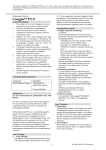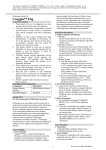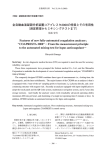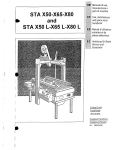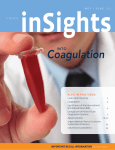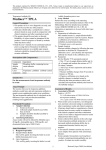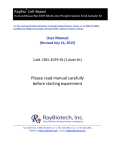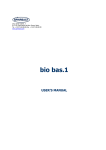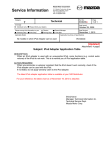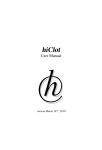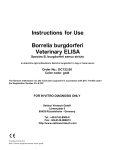Download Coagpia™APTT-N
Transcript
This product marketed by SEKISUI MEDICAL CO., LTD., Tokyo, Japan is manufactured subject to our supervision as stipulated in the Pharmaceutical Affairs Law of Japan and is certified by Registerd Third Party to be marketed in Japan. For details, please contact us or your local distributors. i) Promptly mix 3.2% sodium citrate with blood sample in a 9:1 blood to sodium citrate volume ratio. Centrifuge in a refrigerated centrifuge at 1500G for 15 minutes.2) Transfer the plasma into a separate plastic test tube and refrigerate or store on ice. ii) Avoid contamination with tissue fluid during blood collection, using insufficient amount of sodium citrate solution, and inadequate mixing; as they may yield inaccurate test results. 3) Sample Storage Start the assay promptly after blood collection. For samples stored in the refrigerator or on ice, perform the test within 4 hours 3) after collection. 2. Interfering Substances 1) Assay results will not be affected by free bilirubin (up to 20 mg/dL), conjugated bilirubin (up to 20 mg/dL), hemoglobin (up to 500 mg/dL), formazin turbidity (up to 3,000 units), and Intralipos (up to 5%). 2) Increased coagulation time will result due to heparin. 3) Increased coagulation time may result due to aminoglycoside antibiotic drugs. Activated Partial Thromboplastin Time Kit Coagpia™ APTT-N General Precautions 1. This product is for in vitro diagnostic use only, and must not be used for any other purposes. 2. Clinicians should make a comprehensive clinical decision based on the assay results in conjunction with clinical symptoms and other examination results. 3. Influence on assay values resulting from drug administration is described in Precautions for Use in the package insert for the relevant drugs. In particular, carefully read the section on influence on clinical test results. 4. This product should be used only as directed. Reliability of values cannot be guaranteed if this product is used for purposes or tested by methods other than those stated. 5. If the reagents come in contact with the eyes or mouth, rinse thoroughly with water as first aid, and seek medical treatment if necessary. 6. Read the user’s manual of your automated analyzer prior to using this kit. Parameters for different automated analyzers are available upon request. 7. Perform a quality control test prior to assay to ensure accuracy. Assay Procedure 1. Reagent Preparation APTT Reagent: Ready-to-use Calcium Chloride Solution: Ready-to-use. 2. Assay Method Coagpia™ APTT-N is compatible with various types of blood coagulation analyzers. Below is a general example of the assay procedure. Description (Kit Components) Component Ingredients APTT Reagent Phospholipids (rabbit brain origin) Ellagic acid Calcium Chloride Calcium chloride Solution Intended Use For the measurement of activated partial thromboplastin time with plasma Plasma sample 37°C 50 µL The activated partial thromboplastin time (APTT) test is widely used for evaluating intrinsic coagulation factors and coagulation factor inhibitors, and monitoring heparin therapy.1) APTT reagent 37°C 50 μL Calcium chloride solution 50 µL 37°C Measure coagulation time 3. Operating Precautions 1) Gently mix the reagents by several inversions before use. Do not mix vigorously. 2) After the completion of assay, seal the bottle and store at 2-10°C. Assay Principle 1. Assay Principle After adding phospholipids and ellagic acid to plasma samples for the full activation of contact factors (factor XII, prekallikrein and high-molecular-weight kininogen), calcium chloride is added. The time taken from the addition of calcium chloride to fibrin precipitation (coagulation time: seconds) is referred to as the activated partial thromboplastin time (APTT). Assessment of Results 1. Reference Interval 4) 24-39 seconds Each site is recommended to specify its own reference interval of APTT because the interval differs depending on the analyzer used. 2. Precautions for Assessment There may be reactions with non-target substances or interfering reactions. If results appear unreliable, repeat the measurement (if necessary, after dilution) or try another analytical method. Performance 1. Sensitivity The APTT of undiluted and four-fold diluted normal plasma is 25-35 and 72-119 seconds, Procedural Precautions 1. Sample Collection and Storage 1) Samples Plasma (citrated plasma) can be used. Do not use plasma with anticoagulants other than citrate. 2) Sample Preparation 1 Revised: (Apr) 2011 (3rd edition) This product marketed by SEKISUI MEDICAL CO., LTD., Tokyo, Japan is manufactured subject to our supervision as stipulated in the Pharmaceutical Affairs Law of Japan and is certified by Registerd Third Party to be marketed in Japan. For details, please contact us or your local distributors. lead or copper pipes to produce highly explosive metal azide. Therefore, the reagents should be flushed out with copious amounts of water when discarding. 4. Other Precautions Do not use the containers for any other purposes. respectively. 2. Accuracy 80-120% of the expected assay value 3. Within-run Reproducibility Coefficient of variation ≤ 10% (The test methods used for 1 to 3 are in-house methods.) 4. Measurement Range (on Coapresta 2000) 4) 20-200 seconds 5. Correlation (on Coapresta 2000) 4) 1) N = 95, r = 0.969, y = 0.97x - 0.9 Reference method: Coagulation time method (MHLW approved IVD) 2) N = 92, r = 0.955, y = 0.98x + 0.1 Reference method: Coagulation time method (MHLW approved IVD) Storage and Shelf Life 1. Storage temperature: 2-10C 2. Shelf-life: 2 years from the date of manufacture (The expiration date is printed on the outside of the package.) Package Contents Description Coagpia™ APTT-N Precautions and Warnings 1. Precautions for Handling 1) All samples used in the test should be handled as if potentially infectious for HIV, HBV and HCV. To prevent infection, use disposable gloves and avoid mouth pipetting during the test. 2) Calcium chloride solution contains sodium azide as a preservative. Therefore, if the reagents accidentally come in contact with the eyes, mouth or skin, rinse immediately with water as first aid, and consult a doctor if necessary. 2. Precautions for Use 1) This product should be stored as directed. Avoid freezing. Freezing can cause deterioration of the reagents, which can produce inaccurate results. 2) Do not use expired reagents. The reliability of assay values obtained with expired reagents cannot be guaranteed. 3) Do not replenish the reagents. 4) Do not mix reagents of different lots. 5) Do not perform the assay under direct sunlight. Configuration APTT Reagent 4 mL×10 Calcium Chloride 4 mL×10 Solution Reagents are available in other configurations. Contact SEKISUI MEDICAL CO., LTD. for details. References 1) Masamitsu Kanai: Clinical examination method summary. Kanehara Co., LTD, 32nd edition, pp. 410, 2005. 2) Edited by the Japanese Society for Laboratory Hematology: Standard hematologic tests. Ishiyaku Publishers, Inc., pp. 75-78, 2003. 3) Edited by the Japanese Society for Laboratory Hematology: Standard hematologic tests. Ishiyaku Publishers, Inc., pp. 136-139, 2003. 4) SEKISUI MEDICAL,CO., LTD. In-house data Marketing Authorization Holder SEKISUI MEDICAL CO.,LTD. 13-5, Nihonbashi 3-chome, Chuo-ku, Tokyo, Japan [email protected] 3. Precautions for Disposal 1) Before disposal, used samples and their containers must be soaked in sodium hypochlorite solutions at a concentration greater than 0.1% for more than an hour or autoclaved at 121C for 20 minutes. 2) To prevent infections from spilled samples or solutions containing samples, wipe the spill area thoroughly with disinfectants such as sodium hypochlorite solution at a concentration greater than 0.1%. 3) The reagents and samples should be disposed in accordance with medial waste disposal regulations or related regulations. 4) The reagents should be disposed in accordance with water pollution control regulations or related regulations. 5) The calcium chloride solution contains sodium azide as a preservative, which may react with "Coagpia" is a trademark owned by SEKISUI MEDICAL CO.,LTD. JAPAN, and is registered in Japan and/or other countries. 2 Revised: (Apr) 2011 (3rd edition)


